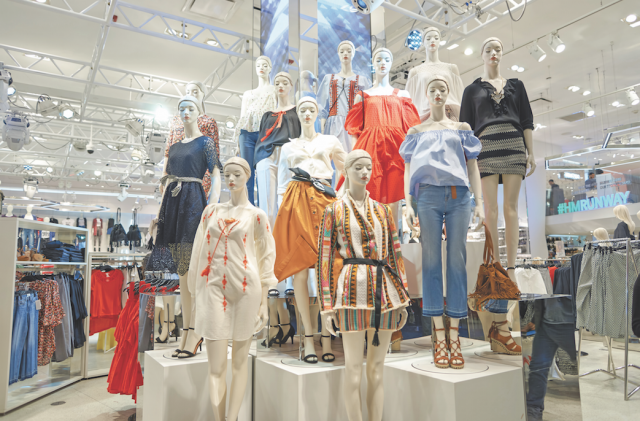Activist blogger Nataly Elbaz Björklund delves into the cost of unsustainable fashion.
How fast is fast enough when it comes to clothes and gratification? Do we really need those shoes, skirt or clutch? These are some of the hard-hitting questions:
By Nina Narisa Pichitsingh
Maxine Bédat begins her TEDx Talk on “The High Cost of Our Cheap Fashion” by telling us: “We hold the power [to make changes] with what we wear every day.” She further explains that the apparel industry has become the second most polluting industry in the world, right after the oil industry. And fast fashion brands play a tremendous role in their demand. Shocking, right?
Maxine is the CEO and co-founder of Zady, an online retailer that aims to provide a sustainable alternative to fast fashion.
The Economics
Today we purchase three times as much as we did in the 60s. The quantity of our clothing has increased as the quality has decreased. Why did this turn of events happen? As trade barriers were removed, financial incentives for brands to move production to countries such as Bangladesh increased, creating a trend for much cheaper clothing, using economical materials and low-cost labour. Though we might not realise it, cheap clothing has dire consequences on the environment and the people making the clothing.
The Faces Behind Fast Fashion
The recent collapse of Rana Plaza that killed 1,130 workers in Bangladesh is an example of how hazardous the working conditions can be in such countries. For fast fashion brands to restock their stores with new collections every week, factories in Bangladesh, for example, are pressured to produce garments more and more quickly, often not complying with standards. Or, alternatively, sub-contract ‘shadow factories’ where workers are paid minimally and live in dangerous conditions.
Remember, the very brands that entice us with low prices and a new collection every week may be responsible for forced child labour, devastating environmental practices and sweatshop conditions, to enable these low prices and rapid production. According to the International Labour Organisation, an estimated 170 million children are engaged in child labour, many working within the fashion supply chain, making textiles and garments.
Fast Fashion is Fueled by Polyester
Polyester, a synthetic fibre, is in approximately 60 percent of today’s clothing. It is actually a polluting plastic made from fossil fuels, making the material’s carbon footprint three times that of cotton. It is non-biodegradable, meaning that every piece of polyester produced is still on the planet today. When you wash polyester, thousands of pieces of microplastics shed and enter water systems and the oceans. As a result, fish are consuming these microplastics, and we are, in turn, consuming the fish. Also, unlike natural fibres, polyester cannot breath. This explains the reason you may be sweating more!
Sustainable Fashion Inspiration
Nataly Elbaz Björklund is a sustainable fashion and ethical luxury blogger under the name Literally Nataly (www.literallynataly.com). The aim of her blog is to create awareness about environmental and social justice issues, and introduce ethical, sustainable, eco-friendly, slow fashion and lifestyle brands. This is something she strongly feels everyone needs to be passionate about “as we only have one Earth, and in order for our Earth to be able to sustain itself in the long term we need to give back what we take.”
Nataly tells Masala why we should reconsider the way we shop and where we shop in an eye-opening interview.
What are high-street brands, fast fashion and slow fashion?
High-street brands are found in most towns, typically chain brands that have many branches or franchises around the world. I encourage people to find alternatives to many high-street brands because they are often not transparent about the way in which they run their business. For example, they might not let their customers know who made their clothes and under what conditions the clothes were made.
Fast fashion brands (high-street brands which rotate their collections numerous times a year) have been known to not take sufficient responsibility to ensure that factory workers work under fair conditions. Many of these brands have large carbon footprints, pollute the environment through their manufacturing processes, use unsustainable materials and make their consumers feel that their garment is disposable when the new collection hits stores the following week. In essence, fast fashion is a disposable product for a short-term trend and lifespan. The problem is that the short-term “benefits” come with serious long-term problems for those involved in the production process as well as
the environment.
Slow fashion, on the other hand, encourages slower production schedules, fair wages, lower carbon footprint and, ideally, zero waste methods. It is about designing, creating and buying garments for their quality and durability.
If one must buy a high-street brand or fast fashion, what advice could
you give them?
Always read the tags! As a conscious consumer, one should question where the clothes are made and what they are made from. Some high-street brands like Monki, for example, make many pieces in their collection from 100 percent organic cotton, while other brands don’t make any effort at all to derive their materials from more sustainable sources. When you see a piece of clothing in a shop, you should also always ask yourself whether you really need that piece, as most of the clothes we buy are variations of clothing items we already own.
What brands can you recommend that are sustainable and have exemplary business models?
Stella McCartney, Patagonia, Reformation, People Tree, Everlane, Eileen Fisher, Swedish Hasbeens , Thought Clothing, Edun, Matt & Nat, Veja and Umran Aysan.
What about the future?
I am hopeful because over the last few years more people in the fashion industry seem to have become further aware of social and environmental issues. There are more sustainable fashion brands now, which is a positive development. At the same time, fast fashion is also growing, so it is important to not simply be content with the growth of a new sustainable fashion industry.
How can we make our closets ‘greener’?
Buy less, buy better. Most of the time when people are going out to buy things, they are buying variations of things that they already own. Make use of what you have in your closet and slowly build a capsule wardrobe with sustainable products. Spend more money on one timeless sustainable piece, rather than buying five less durable fast fashion finds.
How can one help the situation?
There is much you can do, from becoming active or joining online campaigns like Fashion Revolution, to finding out if there are any events in your city, capsuling your wardrobe and challenging yourself to #30wears. Even the smallest action is important. One of the simplest activities is to speak to your friends and raise awareness about the problems with fast fashion. Social injustice and environmental problems concern us all, so it is at the very minimum our duty to be informed about these issues.
Apart from apparel is there anything else we should be aware of in fashion, for example, purses, watches and shoes?
Everything really, from clothes and accessories to even homeware. Everything that we use in our home or put on our body is made somewhere, by someone, from something. Learn about where and how they are made before committing to a purchase.
Documentary and Book Recommendations
- The True Cost (Documentary)
- Before the Flood (Documentary)
- The Wardrobe to Die For by Lucy Siegle (TEDx Talk)
- Naked Fashion: The New Sustainable Fashion Revolution by Safia Minney
- Overdressed: The Shockingly High Cost of Cheap Fashion by Elizabeth L. Cline
- The Sustainable Fashion Handbook by Sandy Black
10 Tips for a Healthy and Innovative Closet
1. Style Vs. Fashion
Invest in style and timeless pieces, rather than pieces that will go out of fashion next month. Creating your own style is unique, personalised and may be more fun and meaningful than fashion.
Jill Chivers, a fashion revolutionist, interestingly defines fashion as the relationship to the external, as it is concerned with “what’s out there” (in stores, in magazines), while she defines style as the relationship to the internal as it is about “what’s in here” (my sense of self, my identity, my perception of who I am). Jill summarises that “fashion takes our attention away from ourselves; style brings our attention directly to ourselves”.
2. Novelty
Try purchasing items from new brands. Do your research and find sustainable brands that are available locally and internationally.
3. Campaigns and Challenges
Rise to the challenge. Learn about campaigns that question the concept of throwaway fashion. #30wears, for example, helps one re-frame shopping trips. Eco-fashion activist Livia Firth encourages women to ask themselves every time when they are about to buy something, “Will I wear this 30 times?” If the answer is “yes”, then buy it. However, many will be surprised at how many times they say “no”.
4. Inventory
Do an inventory of your clothes to remember what you have. This exercise will keep track of what you do not need to buy. Budget enough time to even try on items. If you think about your pieces and pair them now, it will be easier for you to make more use of your closet when you are in a dire rush to a dinner or event.
5. DIY and Creativity
Give old items a second life! With a dose of creativity or even assistance from Pinterest, the options are limitless. Revive an old dress by cutting it into a crop top. Add loose bits of jewellery to a plain top. Utilise fabric paint and templates for a more artistic edge. Repurpose your jeans and pants by cutting them into shorts with a scalloped edge for a new look. Add studs to T-shirts and ethnic fabric patches to jackets.
6. Recycled Plastic Bottles
Though it may still require heavy processing, various companies are now finding ways to create polyester out of recycled plastic bottles or even recycled polyester fabric. Recycled polyester reduces pressure on virgin resources and results in less pollution. Brands such as Nike use 18 recycled plastic bottles to make each soccer uniform for professionals. Quiksilver has also launched stylish board shorts derived from used plastic bottles, while Roxy does the same with beautiful bikinis. You can’t even tell!
7. Try Linen
Linen is made of the flax plant, and interestingly, the whole flax plant can be used, leaving no waste. Flax grows naturally and requires less water and fewer pesticides than cotton, making it one of the most eco-friendly fabrics. As it is a natural fibre, flax linen is recyclable and biodegradable. Linen also provides a coolness due to the weave and nondense fibres that allow for more airflow, making it perfect for hot weather. Other eco-friendly fabrics include bamboo, hemp, fair trade, organic cotton and soy.
8. Go Faux and Alternative
Not only does the production of wool, leather and fur harm millions of animals every year, it also contributes to land devastation, air pollution and water contamination. Multiple brands have created innovative leather alternatives. LIAN&MÉZ, for example, sells beautiful, high craftsmanship watches with straps made from the innovative material Piñatex, made from pineapple leaf fibres.
9. Upcycled Leather
If you still want leather, use leather goods that are repurposed. Parts of the entirety of the old leather product can be used again for another purpose, reducing the need to produce fresh leather pieces. For instance, TRMTAB utilises leather scraps from factories to create unique limited edition refined leather goods, such as bags, shoes, wallets and holders for tech devices.
10. Organic
Look for organic clothing — not genetically modified and not from plants that have been radiated and treated with pesticides. Industrial cotton is the world’s dirtiest crop, and pesticides and insecticides are known carcinogens which are cancer-causers. Protect your health by choosing organic cotton.
“Buy less, choose well, make it last.”
— Vivienne Westwood









